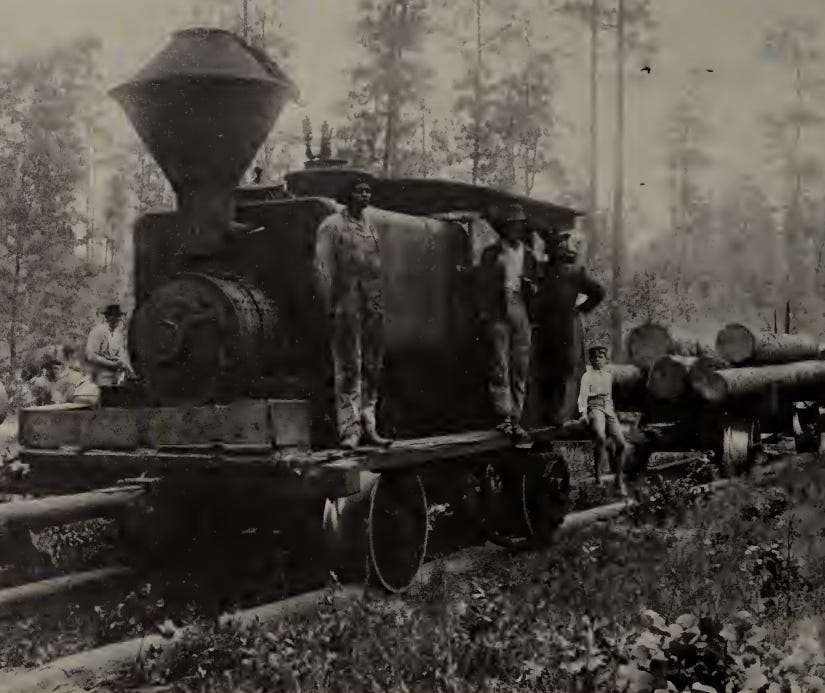Strap Rail
The early history of the United States runs along with the first years of the railroad. A small prototype of a steam-powered locomotive was first built by William Murdoch in 1784, just a year after the Treaty of Paris ended the Revolutionary War. The first working steam locomotive, Richard Trevithick’s Coalbrookdale Locomotive, was built in 1802, and the first public steam railway in the world, George Stephenson’s Locomotion No. 1, was built in 1825.
Early railroad development largely took place in the UK (Murdoch, Trevithick, and Stephenson all built their locomotives there), and early US locomotives were British imports. However, British locomotives were quickly found to have difficulties running on American railroads. British railroads were “models of a civil engineering enterprise”, having:
…carefully graded roadbeds, substantial tracks, and grand viaducts and tunnels to overcome natural obstacles. Easy grades and generous curves were the rule. Since capital was plentiful, distances short, and traffic density high, the British could afford to build splendid railways.
All this engineering came at a cost: early British railroads cost $179,000 per mile to build (though part of this was the cost of land). But because of Britain’s high population density, traffic was high, routes could be short, and so the costs could be recovered.
Conditions in the US were far different. Distances were large, populations were lower, and financing for large engineering projects was in short supply. As a result, US railroads evolved differently than British ones. Rather than being straight, American railroads tended to have winding routes that followed the curve of the land, and avoided tunnels, grading, or expensive civil engineering works. Instead of expensive stone bridges, US railroads used wooden trestles. Locomotives in the US needed to cope with steeper grades and much less robust track than in Britain, and thus needed to be designed differently
One interesting example of the different railroad conditions in the US and Britain is a railroad technology that was briefly popular for early US railroads: the strap rail track. British railroads were built with solid iron rails which, while effective, were expensive. Strap rail, by contrast, was built by attaching a thin plate of iron to the top of a piece of timber. This greatly reduced the amount of iron required to build railroad track — while British track required 91 tons of iron per mile, strap rail required just 25 tons.
This style of construction was far cheaper than British iron rails, just $20,000-30,000 per mile, 1/6th to 1/9th the cost of British rail. Building strap rail substituted comparatively precious iron (which was in short supply in the early US) for wood, which was widely available. By 1840, it’s estimated that 2/3rds of the 3,000 miles of railway in the US was strap rail track.
But this thrift wasn’t without consequence. While cheaper to build than solid iron tracks, strap rail lines decayed quickly, and had incredibly high maintenance costs, over twice as much per mile as iron rail (material culture 192). Rather than being built atop crushed rock (which would allow for proper drainage), strap rail lines were typically placed directly onto the ground. Mold, insects, and moisture quickly went to work on the wooden rails, and after a few seasons they became “a hopeless ruin”. And strap rail lines were dangerous: the repeated impact of the locomotive wheels could cause the iron straps to curl up at the ends of the timbers, in some cases derailing trains
Because of these various deficiencies, strap rail became less and less popular for commercial railroads in the US. In 1847, New York banned the use of strap rail for public railroads, and gave existing railways three years to convert to iron rails. After 1850, new commercial installation of strap rail was rare, and by 1860 most existing mileage had been replaced with solid iron rails.
However, strap rail continued to see some use in other areas. Horse-drawn streetcars, which began to appear in US cities in the 1850s, often used strap rail tracks. The comparative lightness of the streetcars made the downsides of strap rail less acute, and strap rail was a popular choice for streetcar lines until electric streetcars began to replace horse-drawn cars in the 1880s. Strap rail also found occasional use on private, industrial railways, and several such lines were built in the 1860s and 1870s. Here too, however, strap rail eventually fell out of fashion.
An even cheaper type of wooden railway was occasionally built for logging railroads to transport felled timbers: the pole road. A pole road was nothing more than two rows of logs, laid parallel on the ground, and tapered so that one log could fit into the next. “Locomotives”, little more than modified agricultural steam tractors, would ride on top of these poles on flanged wheels that wrapped around the poles. Like strap rail, pole roads were inexpensive to build but decayed incredibly quickly, and by the end of the 19th century had become increasingly rare
The history of technological development emerges from a complex interplay between people working to solve a particular problem (like moving travelers and goods from place to place) and the terrain in which that problem exists. The particular constraints that existed in the early 19th century US — little capital, limited access to iron, low population density — shaped how railway technology developed here, producing technological arcs like the rise and fall of the strap railroad.




This was a nice little read before work today. I'd enjoy more, briefer posts like that--some of the long ones take too long to read, I end up putting it off for a while!
Typo, first paragraph: 1784 not 1884